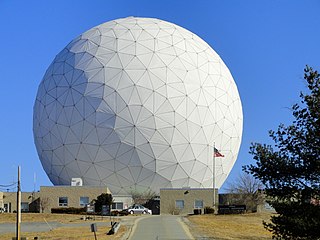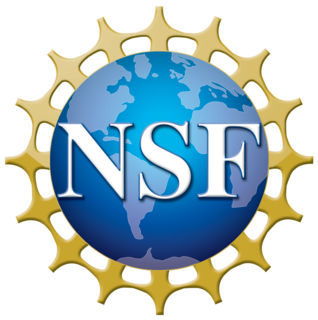
An aurora, sometimes referred to as polar lights, northern lights, southern lights, is a natural light display in the Earth's sky, predominantly seen in the high-latitude regions.

The High Frequency Active Auroral Research Program (HAARP) was initiated as an ionospheric research program jointly funded by the U.S. Air Force, the U.S. Navy, the University of Alaska Fairbanks, and the Defense Advanced Research Projects Agency (DARPA). It was designed and built by BAE Advanced Technologies (BAEAT). Its original purpose was to analyze the ionosphere and investigate the potential for developing ionospheric enhancement technology for radio communications and surveillance. As a university-owned facility, HAARP is a high-power, high-frequency transmitter used for study of the ionosphere.

Nozomi was a planned and launched Mars-orbiting aeronomy probe. It did not reach Mars orbit due to electrical failures. The mission was terminated on December 31, 2003.

The Swedish Institute of Space Physics is a Swedish government agency. The institute's primary task is to carry out basic research, education and associated observatory activities in space physics, space technology and atmospheric physics.
The HIPAS Observatory was a research facility intended to study the ionosphere and its influence on radio communications.
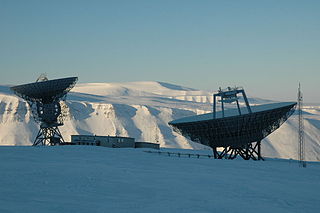
EISCAT operates three incoherent scatter radar systems, at 224 MHz, 931 MHz in Northern Scandinavia and one at 500 MHz on Svalbard, used to study the interaction between the Sun and the Earth as revealed by disturbances in the ionosphere and magnetosphere. At the Ramfjordmoen facility, it also operates an ionospheric heater facility, similar to HAARP. Additional receiver stations are located in Sodankylä, Finland, and Kiruna, Sweden. The EISCAT Svalbard radar (ESR) is located in Longyearbyen, Norway. The EISCAT Headquarters are also located in Kiruna.
Incoherent scattering is a type of scattering phenomenon in physics. The term is most commonly used when referring to the scattering of an electromagnetic wave by random fluctuations in a gas of particles.

The Super Dual Auroral Radar Network (SuperDARN) is an international scientific radar network consisting of 35 high frequency (HF) radars located in both the Northern and Southern Hemispheres. SuperDARN radars are primarily used to map high-latitude plasma convection in the F region of the ionosphere, but the radars are also used to study a wider range of geospace phenomena including field aligned currents, magnetic reconnection, geomagnetic storms and substorms, magnetospheric MHD waves, mesospheric winds via meteor ionization trails, and interhemispheric plasma convection asymmetries. The SuperDARN collaboration is composed of radars operated by JHU/APL, Virginia Tech, Dartmouth College, the Geophysical Institute at the University of Alaska Fairbanks, the Institute of Space and Atmospheric Studies at the University of Saskatchewan, the University of Leicester, Lancaster University, La Trobe University, and the Solar-Terrestrial Environment Laboratory at Nagoya University.
An electrojet is an electric current which travels around the E region of the Earth's ionosphere. There are two electrojets: above the magnetic equator, and near the Northern and Southern Polar Circles. Electrojets are Hall currents carried primarily by electrons at altitudes from 100 to 150 km. In this region the electron gyro frequency is much greater than the electron-neutral collision frequency. In contrast, the principal E region ions have gyrofrequencies much lower than the ion-neutral collision frequency.

Canadian Geospace Monitoring (CGSM) is a Canadian space science program that was initiated in 2005. CGSM is funded primarily by the Canadian Space Agency, and consists of networks of imagers, meridian scanning photometers, riometers, magnetometers, digital ionosondes, and High Frequency SuperDARN radars. The overarching objective of CGSM is to provide synoptic observations of the spatio-temporal evolution of the ionospheric thermodynamics and electrodynamics at auroral and polar latitudes over a large region of Canada.
An ionospheric heater, or an ionospheric HF pump facility, is a powerful radio wave transmitter with an array of antennas which is used for research of plasma turbulence, the ionosphere and upper atmosphere. These transmitters operate in the high frequency (HF) range (3-30 MHz) at which radio waves are reflected from the ionosphere back to the ground. With such facilities a range of plasma turbulence phenomena can be excited in a semi-controlled fashion from the ground, during conditions when the ionosphere is naturally quiet and not perturbed by for example aurora. This stimulus-response type of research complements passive observations of naturally excited phenomena to learn about the ionosphere and upper atmosphere.

Tor Hagfors was a Norwegian scientist, radio astronomer, radar expert and a pioneer in the studies of the interactions between electromagnetic waves and plasma. In the early 1960s he was one of a handful of pioneering theorists that independently developed a theory that explained the scattering of radio waves by the free electrons in a plasma and applied the result to the ionosphere. He became founding director of the new EISCAT facilities that were then under construction in 1975, by which time he already been director at most of the other incoherent scatter radar facilities in the world. The asteroid 1985 VD1 is named 7279 Hagfors after him.
This is an index to articles about terms used in discussion of radio propagation.
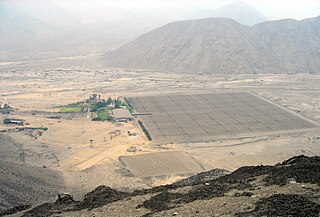
The Jicamarca Radio Observatory (JRO) is the equatorial anchor of the Western Hemisphere chain of Incoherent Scatter Radar (ISR) observatories extending from Lima, Peru to Søndre Strømfjord, Greenland. JRO is the premier scientific facility in the world for studying the equatorial ionosphere. The Observatory is about half an hour drive inland (east) from Lima and 10 km from the Central Highway. The magnetic dip angle is about 1°, and varies slightly with altitude and year. The radar can accurately determine the direction of the Earth's magnetic field (B) and can be pointed perpendicular to B at altitudes throughout the ionosphere. The study of the equatorial ionosphere is rapidly becoming a mature field due, in large part, to the contributions made by JRO in radio science.

The Unwin Radar is a scientific radar array at Awarua, near Invercargill, New Zealand 46.51°S 168.38°E.
The index of physics articles is split into multiple pages due to its size.
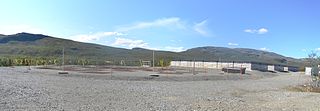
The Kilpisjärvi Atmospheric Imaging Receiver Array (KAIRA) is an astronomical observatory operated by the Sodankylä Geophysical Observatory on behalf of Oulu University. It is located at Kilpisjärvi, Enontekiö near the border with Norway. It comprises two LOFAR-derived radio telescope systems and is capable of observing at HF and VHF radio frequencies. It is used for atmospheric, near-Earth space and astronomical research. KAIRA uses LOFAR phased-array antennas and digital signal-processing hardware. The phased array configuration has no moving parts and with digital control, allows KAIRA to quickly scan the sky, giving KAIRA a large field of view. KAIRA can produce a continuous all-sky image of the radio transparency of ionosphere, using cosmic radio noise for "illumination" (riometry). KAIRA can also obtain electron density profiles in the atmosphere. This allows the study of the interaction of the solar wind with the atmosphere, such as in aurora borealis and other space weather phenomena. In addition to near-space imaging, the use of KAIRA has been demonstrated for long-baseline interferometry observations of pulsars.


